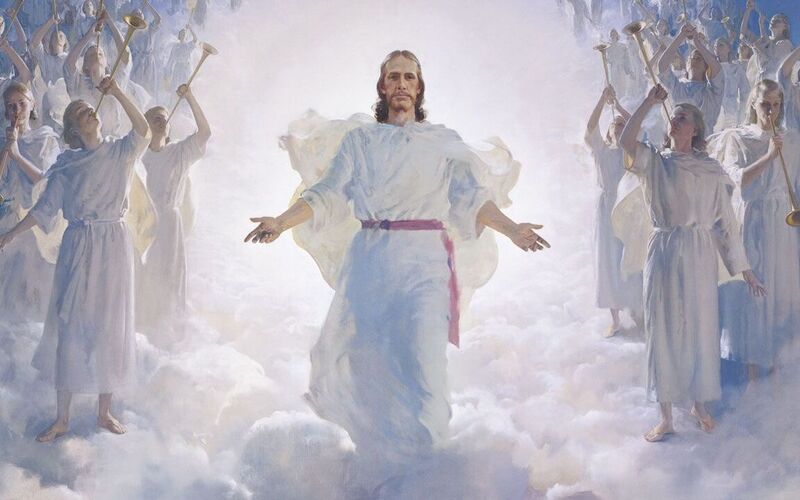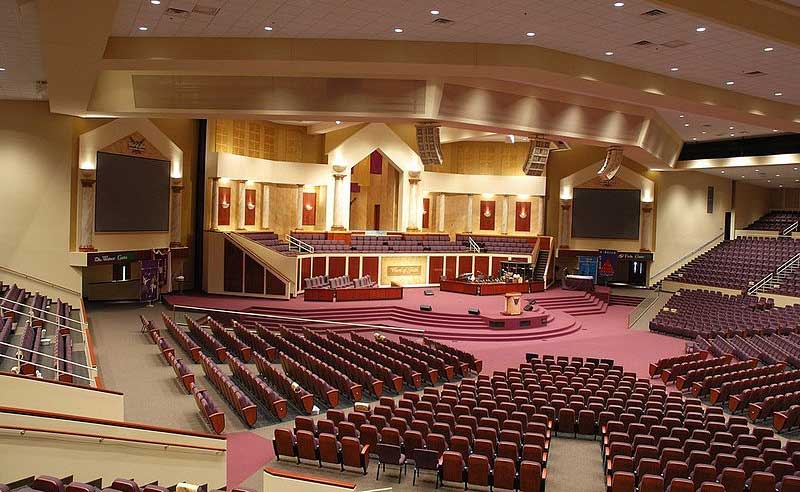Second Coming Of Jesus Christ
The Second Coming of Jesus Christ (sometimes called the Second Advent or the Parousia) is a Christian (as well as Islamic and Baha’i) belief that Jesus will return after his ascension to heaven about two thousand years ago. The idea is based on messianic prophecies and is part of most Christian eschatologies.
Views about the nature of the Second Coming vary among Christian denominations and individual Christians. Many specific dates have been predicted for the Second Coming, some now in the distant past, others still in the future.

Conflict of opinion about the date of the return of Jesus:
Second Coming Of Jesus Christ in Christianity:
Jesus told his disciples:
“Truly I tell you, this generation will certainly not pass away until all these things have happened. Heaven and earth will pass away, but my words will not pass away.”
— Matt. 24:34-35; Mark 13:30-31; Luke 21:32-33
The most common English translation of genea is “generation” which leads some to conclude that the Second Coming was to be witnessed by the people living in the same generation as Jesus.
in most German Bibles, genea is instead translated as “family/lineage” (Geschlecht). Likewise for Danish, Swedish, and Norwegian (slægt, släkte, and slekt, respectively). The Danish linguist Iver Larsen argues that the word “generation” as it was used in the King James Version of the Bible (1611) had a much wider meaning than it has today and that the correct translation of genea in the context of the second coming is “kind of people.” (specifically the “good” kind of people; who, like the words of Jesus, will endure through all the tribulations).
Bible scholar Philip La Grange du Toit argues that genea is mostly used to describe a timeless and spiritual family/lineage of good or bad people in The New Testament and that this is the case also for the second coming discourse in Matthew 24. In contrast to Larsen however, he argues that the word genea here denotes the “bad” kind of people,” because Jesus had used the word in that pejorative sense in the preceding context (chapter 23.) He also lists the main competing translation alternatives.
In addition that the position associating the Second Coming with 1st-century events such as the destruction of Jerusalem and the Jewish Temple in AD 70 is known as Preterism. Some Preterists see this “coming of the Son of Man in glory” primarily fulfilled in Jesus’ death on the cross.
They believe the apocalyptic signs are already fulfilled including “the sun will be dark” ( Mark 13:24–15:33), the “powers … will be shaken,” (Mark 13:25–14:63, 15:5), and “then they will see” (Mark 13:26–15:31, 15:39). Yet some critics note that many are missing, such as “But the day of the Lord will come as a thief in the night, in which the heavens will pass away with a great noise, and the elements will melt with fervent heat; both the earth and the works that are in it will be burned up.” (2 Peter 3:10). And “Then the sign of the Son of Man will appear in heaven, and then all the tribes of the earth will mourn, and they will see the Son of Man coming on the clouds of heaven with power and great glory.” (Matthew 24:30).
According to the Catholic Church, the second coming will bring about the fullness of the reign of God and the consummation of the universe, mankind, and salvation. The Catholic Church believes three things hasten the return of Jesus: the transforming power of the Holy Spirit in the liturgy; living with the mind of Jesus; and praying for the Lord to come, above all in the Eucharist.
It is the traditional view of Orthodox Christians, preserved from the early Church, that the Second Coming will be a sudden and unmistakable incident, like “a flash of lightning”.[Mt 24:27] They hold the general view that Jesus will not spend any time on the earth in ministry or preaching, but come to judge mankind. They teach that the ministry of the Antichrist will take place right before the Second Coming.
A reference to the second coming is contained in the Nicene Creed and Apostles Creed, which is recited during the Lutheran and Anglican liturgies: “He [Jesus] shall come again in glory to judge the living and the dead, and His kingdom shall have no end.” An analogous statement is also in the biblical Pauline Creed (1 Corinthians 15:23).
The Lutheran and Anglican churches proclaim the Mystery of Faith in their liturgies: “Christ has died, Christ is risen, Christ will come again.
Some Methodist denominations teach that the Second Coming is connected with the Last Judgement. The Emmanuel Association, a Methodist denomination in the conservative holiness movement teaches:
We believe that the second coming of Our Lord is to be personal and premillennial, also that it is imminent (Acts 1:9-11; 1 Thessalonians 4:14-17; Matthew 25:13; Revelation 22:12). We must distinguish between the Rapture His coming in the air to receive His saints, which may occur at any moment and the Revelation His coming down to earth with His saints (2 Thessalonians 1:7-10; Matthew 24-27; 26:29; Revelation 20:4), which latter will not occur until after the gathering of Israel, the manifestation of the Antichrist, and other prophesied events (2 Thessalonians 2:8-10; Revelation 19:20).
The standard works of the largest denomination in the Latter-Day Saints movement, The Church of Jesus Christ of Latter-day Saints (LDS Church), say that Christ will return, as stated in the Bible. They also teach that.
When the Savior comes again, He will come in power and glory to claim the earth as His kingdom. His Second Coming will mark the beginning of the Millennium. The Second Coming will be a fearful, mournful time for the wicked, but it will be a day of peace for the righteous.
The LDS Church and its leaders do not make predictions of the actual date of the Second Coming.
Fundamental Belief #25 of the Seventh-day Adventist Church states:
The second coming of Christ is the blessed hope of the church, the grand climax of the gospel. The Saviour’s coming will be literal, personal, visible, and worldwide. When He returns, the righteous dead will be resurrected, and together with the righteous living will be glorified and taken to heaven, but the unrighteous will die.
The almost complete fulfillment of most lines of prophecy, together with the present condition of the world, indicates that Christ’s coming is imminent. The time of that event has not been revealed, and we are therefore exhorted to be ready at all times.
Jehovah’s Witnesses rarely use the term “second coming”, preferring the term “presence” as a translation of parousia. They believe that Jesus’ comparison of “the presence of the Son of man” with “the days of Noah” in Matthew 24:37–39 and Luke 17:26–30 suggests a duration rather than a moment of arrival. They also believe that biblical chronology points to 1914 as the start of Christ’s “presence”, which continues until the final battle of Armageddon.
Other biblical expressions that correlate with this period include “the time of the end” (Daniel 12:4), “the conclusion of the system of things” (Matthew 13:40,49; 24:3), and “the last days” (2 Timothy 3:1; 2 Peter 3:3). Witnesses believe Christ’s millennial reign begins after Armageddon.
Emanuel Swedenborg, an 18th-century scientist turned theologian, taught that his time (historians have called the Age of Enlightenment) was an age of darkness and doubt for the Christian church. Historian Marguerite Beck Block writes,
Now therefore it was time for a new church to be founded upon the earth, and for this purpose, the Lord Himself needed to make his Second Coming to the sons of men.
“The night is followed by a morning which is the coming of the Lord. . . . The prevailing opinion in the churches at the present day is, that when the Lord shall come for the last judgment. He will appear in the clouds of heaven with angels and the sound of trumpets, etc.,” but this opinion is erroneous.
The Second Coming of the Lord is not a coming in person, but in spirit and in the Word, which is from Him, and is Himself. . . . Heretofore it has not been known that ‘the clouds of heaven’ mean the Word in the sense of the letter, and that the ‘glory and power’ in which He is then to come, mean the spiritual sense of the Word, because no one as yet has had the least conjecture that there is a spiritual sense in the Word, such as this sense is in itself. But as the Lord has now opened to me the spiritual sense of the Word, and has granted me to be associated with angels and spirits in their world as one of them, it is now disclosed.
. . . This Second Coming of the Lord is effected by means of a man to whom the Lord has manifested Himself in Person, and whom He has filled with His Spirit, that he may teach the doctrines of the New Church from the Lord by means of the Word. . . . That the Lord manifested Himself before me. His servant, and sent me to this office, . . . I affirm in truth.”
In Max Heindel’s teaching, there is a distinction between the cosmic Christ, or Christ without, and the Christ within. According to this tradition, the Christ within is regarded as the true Saviour who needs to be born within each individual to evolve toward the future Sixth Epoch in the Earth’s etheric plane, that is, toward the “new heavens and a new earth” the New Galilee.
The Second Coming or Advent of the Christ is not in a physical body, but in the new soul body of each individual in the etheric plane of the planet where the man “shall be caught up in the clouds to meet the Lord in the air.”The “day and hour” of this event is not known. The esoteric Christian tradition teaches that first there will be a preparatory period as the Sun enters Aquarius, an astrological concept, by precession: the coming Age of Aquarius
Second Coming Of Jesus Christ in Islam:
on the Quran, the second coming of Jesus is heralded in Sura Az-Zukhruf as a sign of the Day of Judgment.
And (Jesus) shall be a Sign (for the coming of) the Hour (of Judgment): therefore have no doubt about the (Hour), but follow ye Me: this is a Straight Way. 43:61
According to Islamic tradition, Jesus’ descent will be in the midst of wars fought by the Mahdi (lit. “the rightly guided one”), known in Islamic eschatology as the redeemer of Islam, against the al-Masih ad-Dajjal (literally “the false messiah”, synonymous with the Antichrist) and his followers.
Jesus will descend at the point of a white arcade, east of Damascus, dressed in saffron robes his head anointed. He will then join the Mahdi in his war against the Dajjal. Jesus, considered in Islam as a Muslim (one who submits to God) and one of God’s messengers, will abide by the Islamic teachings.
Eventually, Jesus will slay the Antichrist Dajjal, and then everyone from the People of the Book (ahl al-kitāb, referring to Jews and Christians) will believe in him. Thus, there will be one community, that of Islam. Sahih Muslim, 41:7023
After the death of the Mahdi, Jesus will assume leadership. This is a time associated in the Islamic narrative with universal peace and justice. Islamic texts also allude to the appearance of Ya’juj and Ma’juj (Gog and Magog), ancient tribes that will disperse and cause disturbance on earth. God, in response to Jesus’ prayers, will kill them by sending a type of worm into the napes of their necks.
Jesus’ rule is said to be around forty years, after which he will die, (according to Islam Jesus did not die on the cross but was taken up to heaven and continues to live until his return in the second coming). Muslims will then perform the Salat al-Janazah (funeral prayer) for him and bury him in the city of Medina in a grave left vacant beside Muhammad
The Ahmadiyya movement believe that the promised Mahdi and Messiah arrived in the person of Mirza Ghulam Ahmad (1835–1908). This is widely rejected by other Muslims, who do not regard Ahmadis as a legitimate sect of Islam.
The hadith (sayings of the Islamic prophet Muhammad) and the Bible indicated that Jesus would return during the latter days. Islamic tradition commonly depicts that Jesus, upon his second coming, would be an Ummati (Muslim) and a follower of Muhammad and that he would revive the truth of Islam rather than fostering a new religion.
The Ahmadiyya movement interpret the Second Coming of Jesus prophesied as being that of a person “similar to Jesus” (mathīl-i ʿIsā) and not his physical return, in the same way as John the Baptist resembled the character of the biblical prophet Elijah in Christianity.
Ahmadis believe that Mirza Ghulam Ahmad (the founder of the movement) demonstrated that the prophecy in Muslim and Christian religious texts were traditionally misunderstood to suggest that Jesus of Nazareth himself would return, and hold that Jesus survived the crucifixion and later died a natural death. Ahmadis consider Ghulam Ahmad, in both his character and teachings, to be representative of Jesus, and that he attained the same spiritual rank of Prophethood as Jesus.
Thus, Ahmadis believe this prediction was fulfilled and continued by his movement.
Second Coming Of Jesus Christ in Baháʼí Faith:
According to the Baháʼí Faith, the Second Coming is a gradual process that coincides with the advancement of human civilization from the beginning of humanity. It teaches that the founders of the major world religions each represent a return of the Word and Spirit of God as a new, unique personification sent by God, who introduces new teachings, laws, and revelations, such that all major religions are part of a progressive revelation.
Followers of the Baháʼí Faith believe that prophecies of the second coming of Jesus (along with prophecies from other religions) were fulfilled by his forerunner the Báb in 1844 and then by the events occurring during the days of Bahá’u’lláh. They believe that the fulfillment of Christian prophecies by Baha’u’llah is similar to Jesus’ fulfillment of Jewish prophecies.
In both cases, people were expecting the literal fulfillment of apocalyptic statements that led to rejections of the Return, instead of accepting fulfillment in symbolic and spiritual ways. Baháʼís understand that the return of Christ with a new name was intended by Jesus to be a Return in a spiritual sense, due to Jesus explaining in the Gospels that the return of Elijah in John the Baptist was a return in a spiritual sense
Second Coming Of Jesus Christ in Judaism:
Regarding the Christian idea that these prophecies will be fulfilled during a “second coming,” Ohr Samayach states “we find this to be a contrived answer since there is no mention of a second coming in the Jewish Bible. Second, why couldn’t God accomplish His goals the first time around?” Rabbi David Wolpe believes that the Second Coming was “grown out of genuine disappointment. When Jesus died, true believers had to theologically compensate for the disaster.
Second Coming Of Jesus Christ in Rastafari:
In the early developments of the Rastafari religion, Haile Selassie (the Ethiopian Emperor) was regarded as a member of the House of David, is worshipped as God incarnate, and is thought to be the “black Jesus” and “black messiah” – the second coming of Christ.
It was claimed that Marcus Garvey preached the coming of the black messiah on the eve of Selassie’s coronation. Due to this prophecy, Selassie was the source of inspiration for the poor and uneducated Christian populations of Jamaica, who believed that the Emperor would liberate the black people from the subjugation of European colonists.
Paramahansa Yogananda’s commentary about the Second Coming Of Jesus Christ:
In modern times some traditional Indian religious leaders have moved to embrace Jesus as an avatar, or incarnation, of God. In light of this, the Indian guru Paramahansa Yogananda, author of Autobiography of a Yogi, wrote an extensive commentary on the Gospels published in 2004 in the two-volume set The Second Coming of Christ: The Resurrection of the Christ Within You.
The book offers a mystical interpretation of the Second Coming which is understood to be an inner experience, something that takes place within the individual heart. In the introduction of this book, Yogananda wrote that the true Second Coming is the resurrection within you of the Infinite Christ Consciousness. Also stated in the Book of Luke – “Neither shall they say, Lo here! or, lo there! for, behold, the kingdom of God is within you.”
World Religions
Read also:
Believe In God | 9 Reasons People Don’t Believe In God
Sunni Islam | Meaning, Definition, And Doctrines of the Sunnah and their spread



